|
A.P.O.
704
- 2 -
Gifford said thirty to forty Japs
had run out of the battery just before the flames erupted.
Along with the Americans, they had raced shoulder to shoulder toward the cliffs,
with only one thought in mind for this brief moment.
That single thought was to escape the terrible tongues of flame which were
reaching out seeking to engulf them.
One D Company man, Pfc. Thomas T. DeLane was killed.
One man broke his leg and was dragged along by his buddies in terrible
pain. It was later determined that
about 65 Japs were incinerated inside the battery.
It was quiet in our sector, as
though the war was over.
Battery Wheeler was dead.
There were no machine guns in Crockett Ravine.
There was not even an occasional Jap popping up out of nowhere to shoot someone
in the head. No sniper bullets
rattled your eardrums as they cracked within inches of you head.
The 850 Japs must be dead.
Todd and some of the others picked up souvenirs, but I could not develop any
interest. Some of the mortar men from their position near Building 28-D
came out and took pictures standing beside the old M-3 AA guns. I was tired,
dirty, hot, and thirsty, and if it crossed my mind that as 1st platoon commander
I should commit my thoughts to my diary, there was always something more
important to do. The next entries
appear only after we got back to Mindoro.
All this after only two days and nights.
The 1st Battalion arrived
yesterday afternoon and with them were my six missing men: Staff Sergeant
Charles M. McCurry, Pfc. Marion E. Boone, Pfc. Ralph E. Iverson, Pfc. Paul A
Narrow, Pfc. Theodore C. Yocum and Pfc. Bill McDonald. Near noon we moved back to Officers Quarters 28-D.
We were issued 2 or 3 K-rations and a canteen of water.
This was the second canteen of water we had received on Corregidor.
We had jumped with two canteens full,
so that in all, we had four canteens of water issued to us to see us
through the first three days on Corregidor.
Actually we wouldn't get more water until the next day, 19 February. This
would be about the middle of the afternoon when we reached the long barracks.
The
company history does not give the date nor circumstances of the death of Pfc.
William W. Lee. The 2nd platoon was withdrawn from the NCO Quarters the
morning of the 18th. They moved in
and around Officer's Quarters 27-D. Lee
and several others were in one of the first floor rooms. Lee slipped off his webbed harness and let it slide to the
floor. Speaking of Ed Flash's 'Hornet's
Nest' from which he had just come, he exclaimed, "Boy, I'm glad to be
out of there!" He lay down on
the floor, put his head on his musette
bag and, as he did, a
large chunk of concrete fell from the wall, crushing
his skull and killing him.
The
1st platoon was given the mission of capturing one of the Batteries far out on
the western end of the island. I
now know it as Battery Smith, for I know the names of all the Batteries today, but at that
time we did not know the names of many of the batteries until we were close
enough to read them, if that was possible. The same goes for the names of the
hills. What are today Way Hill, and Hearn
Hill were in those early days, 'Bailey's Hill' or 'Calhoun's Hill,' often
spoken with a pointing gesture in the air in the general direction of the
feature.
The
briefing
was given on a barely adequate map, since the area was far out of sight.
There were no adequate maps on Corregidor, and even the maps we had did not
identify the batteries, so it was a case of making do with what we
had. There were no provisions for supporting fire.
We had only the platoon SCR-536 radio, so we would be out of
communication, for we had learned by experience it would be another case of
"out of sight, out of contact."
I was to follow the trolley tracks to first of the batteries (Hearn),
turn west, and follow the ridge to the objective.
The nearest troops would be the remainder of F Company upon
Topside about 700 yards away, but with no reliable way to contact them should it
become imperative.
In
addition to drawing water and rations we replenished our ammo supply.
Fortunately the supply of ammo was plentiful.
The riflemen filled the pouches on their rifle belts and some picked up
an extra bandolier of 8 clips. Thus
they all had 128 rounds of ball and some had 192 rounds.
The BAR's and TSMG's were equally well supplied.
There were no machine guns or other supporting weapons attached.
The
Company left before we did. They
were going to the west end of the long barracks.
We waited until C Company moved in to relieve us.
They also relieved D Company at Battery Wheeler.
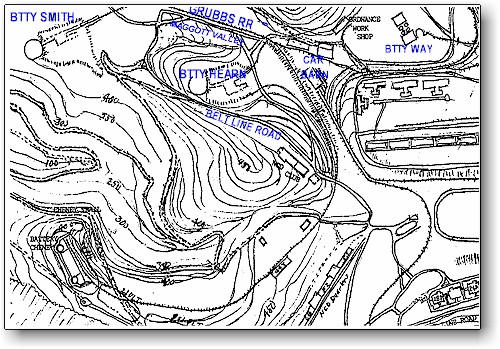
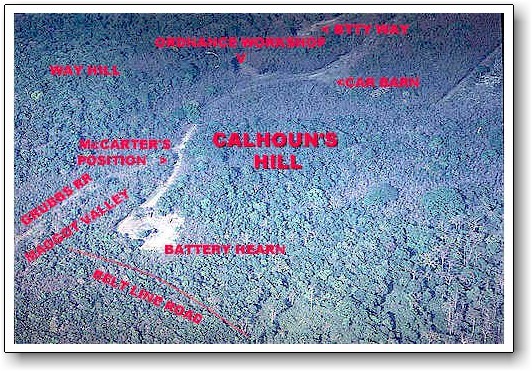
We
moved out following the trolley bed. The
tracks had been removed near Battery Wheeler.
We moved to the northwest, below Topside. The area was wooded, having escaped heavy bombardment.
As a consequence we had to move cautiously, pausing to investigate
suspicious areas. There were a
number of parallel tracks leading to a car barn, but we followed the tracks west
of these. This set of tracks was in
a cut with concrete walls. We moved along the east side of the cut until we came to a
cut-down where we could go down through the concrete walls and up to the other
side. The cut-down was well
constructed with concrete walls. Down
at the track level we could see that the railroad cut deepened as it ran to the
northwest. The walls appeared to be
12 to 14 feet tall. The cut curved
on out of sight to the left. After
we climbed up to level ground on the west side of the cut we could see the bare,
bomb-scarred hill which covered the Battery Hearn Magazine.
No foliage was left.
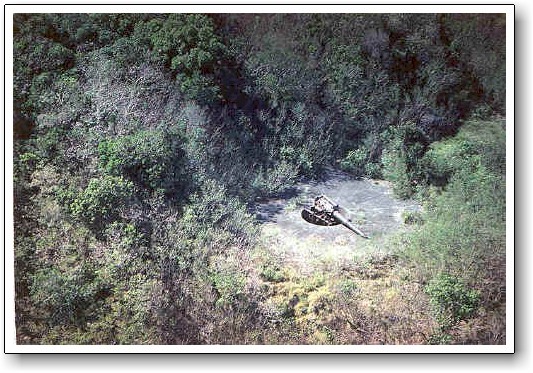
Battery
Smith. The jungle always wins. (Photo by courtesy of Al McGrew)

Battery
Hearn. The hill atop the magazine at the rear is now overgrown. (Photo by courtesy
of Richard Marin)
Both
Batteries Hearn and Smith were 12 inch barbette mounted guns, 340 yards distant
from each other. They sat in the
middle of huge, round concrete pads. This
gave them the appearance of bull's-eyes since they were out in the open.
Adjoining the concrete pad to the east of each gun was its magazine,
which was covered with dirt forming a fair sized hill.
The man-made hills had very steep sides on the north, west, and south.
The east side of Smith was steep but not so severe as the other sides.
The east side of Hearn was more of a gentle slope which was easy to
ascend.
Originally
Smith was Battery Smith 1, and Hearn was Battery Smith 2. They were less formally known to the men of pre-war
Corregidor as the Smith Brothers, Pat and Pending (after a popular radio
commercial of the day) and in their day they presented a fearsome twosome. Because of their barbette mounts they could elevate higher
than the disappearing guns in the other batteries.
This allowed them to fire shells at a greater range of 17 miles, so an
enemy fleet approaching would come under their fire first.
On October 29, 1937, Battery Smith 2 was renamed Battery Hearn in honor
of Brigadier General Clint C. Hearn, a former Harbor Defense Commander.
This battery was gas proofed, or its magazine was.
When the gun was fired at the Japs in Cavite in 1942, the muzzle blast of
the first round blew one of the gas proofing doors off its hinges.
These batteries were located on a ridge running east-west.
West
of Battery Smith several hundred yards away on the ridge had been the 155mm gun
Battery Sunset, comprising six guns. The
ridge is named Sunset Ridge. Way Hill dropped toward the sea as does Sunset
Ridge. About 500 yards from the sea
and located on Way Hill's ridge is Battery Grubbs.
The western end of the valley between Batteries Smith and Grubbs is a rim
which drops off sharply into a deep ravine. Although the name was not on the map
we feel this was Grubbs Ravine because of
the battery on one side and Grubbs
Trail on the other side,
and always called it that.
Sunset
Ridge drops off sharply on its south side to form the north side of Cheney
Ravine; its north side forms the south side of Grubbs Ravine.
Way Hill's ridge forms the north side of Grubbs Ravine.
Grubbs Ravine descends very rapidly to the sea.
Like Cheney and James Ravines, Grubbs Ravine is a natural approach to
Topside.
There
is the railroad cut to the east of Battery Hearn which extends on to the
northwest. From this region a rail
spur comes to the northeast corner of the Battery Hearn magazine and enters a
short tunnel which leads into the magazine.
Proceeding
east along Grubbs Railroad as one nears Battery Smith a rail spur branches of
going downhill into a long tunnel into Battery Smith magazine.
Belt
Line Road passes just east of Battery Grubbs, passes into the valley between
Sunset Ridge and Way Hill where it intersects the road from Topside to Battery
Grubbs, and then over Sunset Ridge about midway between Batteries Hearn and
Smith. The road then runs
along the side of Sunset Ridge (in Cheney Ravine) within about 100 yards of
Battery Hearn. It is in a cut in
this area and is further concealed from Hearn magazine by trees.
A
short distance north of the trees concealing Belt Line Road is the beginning of
an area of desolation. Bombardment
had rendered the area of Batteries Hearn and Smith almost completely devoid of
all vegetation. Only debris and a
heavy dust cover remained. During early 1945, 28 January until 16 February, the
B-24's of the 307th Bomb Group joined by A-20's of the 3rd Attack Group dropped
3,128 tons of bombs on Corregidor, making it one of the most heavily bombed 1735
acres of the war. Other units joined in, but these were the principle units.
Actually the destroyed areas included Batteries Cheney, Wheeler, Boston,
the parade ground, and surrounding areas.
As
we advanced west along Sunset Ridge, Johnson's squad led the platoon with the
1st squad echeloned on their right covering the area down to the valley and
Grubbs Railroad and the parallel road. Lloyd
McCarter lead the way followed by 2nd scout John Bartlett.
Bill McDonald led the 1st squad as 1st scout."
John
Bartlett
"I
remember Lt. Bailey telling us to go take that hill, never knew the name.
The first time I came up out of the cut-down and on to the Hearn
Magazine, McCarter was 1st scout, I
was 2nd, and you, Bill, were third as always. I had never scouted before.
McCarter was so fast I could hardly keep up. When we reached
the top without opposition we threw hand grenades down the ventilator shaft."
Bill
Calhoun
"None
of us knew the name of this battery or Smith, either.
The magazine at Hearn simply came to be called Calhoun's Hill.
Way Hill became Bailey's Hill in the same way. We would name the
valley between Sunset Ridge and Way Hill 'Maggot Valley' in a couple of
days, so I will use this name from here on.
We
advanced in open squad column until we reached Battery Smith. No opposition had been encountered. As the platoon approached
the northwest side of Smith magazine, one of the Tennessee men, called out to
Bill McDonald that he could see a Jap looking at them through field glasses.
Bill looked to check, spotting the Jap officer's head showing slightly
above ground level. At that moment, the trooper who had called out fired his M-1, and Bill saw
the binoculars almost cut in half at the hinge. Of course the Jap died
instantly. When they got there the body was on steps leading to a door of an
underground room or tunnel (probably the oil house for the battery)"
John
Bartlett
"I
remember the Jap looking through binoculars.
We were on patrol and Aimers said "I just saw a Jap down there, and
I shot him, and I want those binoculars when we get there." The distance was so great that I didn't think he saw a Jap,
let alone shot one. When we got
there, sure enough, at the bottom of the steps lay a Jap with binoculars lying
beside him. I tried to throw a hand
grenade through the door at the bottom of the steps.
It hit the side of the door and landed beside the dead Jap and the
binoculars. Later on Aimers proved
that he anything he could see he could hit."
Bill
Calhoun
"The
flamethrower operator came up and hosed down the doorway.
Several Japs ran out and were shot down. Later, after things cooled off, and unknown to the rest of
the platoon, they opened the steel door. Moving
cautiously inside they went into a room filled with cases of whiskey, San Miguel
Beer, and a 5-gallon jug of sake."
Bill
Freihoff
"Earlier
they had found some liquor, and the best I can remember is after Bill Bailey
destroyed the loot."
Bill
Calhoun
"On the afternoon of
the 16th, before we'd undertaken any action, some troopers had found a supply of
alcohol stored in one of the houses along Senior Officers Row. Lampman recalled
it was Bacardi Rum. When Bailey got wind of the find, he broke every bottle
which some of the more thoughtful had not hidden. Now at Smith, the 1st
squad was making sure that this was kept secret. Actually, the 1st squad were
not drinkers, but it was well known that there wasn't anything better to trade,
and they liked bread. In this instance, they ended up with bread, and Major
General Marquat ended up 'without bread.'
We
occupied Battery Smith at about 1500 hours.
As I was deploying the platoon into a defensive position, a 50 caliber
machine gun opened up on us from a wood covered knoll about 100 yards west on
Sunset Ridge. Each time the gun
fired, an area of vegetation would shake. It
was very obvious where the fire was coming from.
Pfc. Benedict Schilli, 3rd squad BAR gunner, went down into a prone
position right out there on the bare concrete pad with neither cover nor
concealment and fired back. I was in the act of yelling for him to get back with
us when the 50 caliber fire ceased, it became quiet, and the vegetation ceased
moving.
Two days later on patrol we reached this
position and found an abandoned 50-caliber machine gun which had been disabled
by a bullet striking the receiver. A camouflage net laced with vegetation had
been strung up vertically in front of the gun.
The gun actually fired through the net, which was tied to stakes in the
ground at the bottom and tree branches at the top.
Whoever prepared this position had little or no knowledge of camouflage
techniques. There was also dried blood on the leaves on the ground.
The
dominant feature was the hill built over Battery Smith's magazine.
It could easily be defended because of its steep sides.
I was preparing to move the platoon up on the hill and assign the squads
their defensive sectors. After
setting up our defensive positions I intended to search the tunnel and the rooms
under the magazine. This could have
been disaster if part of the Japanese force was occupying these large spaces,
waiting in position to make the assault that night.
Later
developments would reveal that a force of some size had been in the tunnel and
the magazine rooms at some time. If
the large Japanese force was there in position to make the attack that night
they would hardly have tipped their hand to attack a small force such as ours.
Of course, had we entered their hideout and discovered their presence,
they would very likely have wiped us out with their superior force.
As we rested in our defensive position atop this great unknown, we were
all uneasy, feeling so alone and far from home,
way out near the sea, and out of sight and radio contact with our forces.
Our
apprehensions ended when a messenger arrived from Lieutenant Bailey instructing
me to withdraw to the battery to our east.
We would receive reinforcements. I
was to set up my force on the bald hill, Battery Hearn magazine, and defend it
and the immediate area. This was
about 1700 hours. I immediately
moved the platoon out for the bald hill, glad to be moving back among friends.
I
have often wondered if Battery Hearn was our objective,
rather than its brother, Battery Smith.
I did not know at the time that the Company was slated to defend Way
Hill, too. Regardless, we got the grand tour,
killed a few Japs and destroyed a 50-caliber enemy machine gun.
Our
route back to the bald hill above the magazine of Battery Hearn was along the
crest of the ridge. We walked
across the concrete pad and climbed the concrete stairs to the top of the hill.
The reinforcements were just arriving, and were substantial: two rifle squads
from the 2nd platoon, the two conventional gun squads from the mortar platoon, a
light machine gun section from the 3rd platoon of our battalion headquarters
company, and a bazooka team. We
already had a flame thrower team who had accompanied us that afternoon attached
to my platoon. 1st Lieutenant Dan
Lee had been assigned to our company that day and led the reinforcements over
from the other half of the company set up on Way Hill, about 250 yards to the
northeast. Battalion sent 2nd Lieutenant John Mara, on loan for the night, to
help out. I never understood why he
was not transferred to F Company. Even
with the addition of Lee, F Company
still only had three officers. Both
D and E Companies still had six officers at this time. The two F Company forces
numbered about seventy men in each for including all reinforcements. The RCT S-3 overlay shows F Company defending an area
extending about a mile from the bottom of Cheney Ravine to the south-west, on
northeast to the western slopes of James Ravine: and northwest of Battery Way.
A force of one hundred and forty men could not physically occupy such a
distance in a perimeter defense, nor did this appear to be the intention of
Lieutenant Brown, because he told Lieutenant Bailey that he wanted him to defend
Way Hill and Battery Hearn magazine hill. The
two forces were barely adequate for this task, if indeed they were adequate.
The
road to Battery Grubbs was closely paralleled by the railroad. The distance from our position out to the road was about
eighty yards. I placed my machine guns on the north side facing the road so that
they could place enfilading fire down the road toward Battery Grubbs.
I had the two mortars zero in on the road and railroad, for the road was
a direct approach to topside, so it was logical that an enemy attack toward
topside would probably use this road. We
had looked down Grubbs Ravine from Battery Smith and knew there could be many
enemy troops down there, though we
never thought there might be many in the Smith magazine and tunnel.
Part of Way Hill was still wooded so that Bailey and his men could not
see down into Maggot Valley; nor could they see us or we them. It was for this reason I was given the two conventional
mortars.
There were no trees or
vegetation anywhere around our position, with the exception of Cheney Ravine on
the south. About fifty yards south
were some clumps of trees. These
helped conceal Belt Line Road as it ran along the upper reaches of Cheney
Ravine. The road was also in a cut, and we did not know at the time that there
was a road there. The further down
Cheney Ravine the heavier the forest became, so that soon after passing Belt
Line Road the forest was thick and
offered complete concealment. To
us, in the late afternoon, it appeared dark and sinister, as it would indeed
prove to be.
Our
hill was a formidable position. It
was rectangular in shape, about eighty yards long (east-west), and forty yards
across (north-south). As previously
stated three sides were very steep. The
west side was so steep that concrete stairs had been built to mount this face.
The north and south side could be climbed only with great difficulty.
In addition the south side had a huge crater in the slope which made
climbing it impossible in the central area.
The east slope was a gentle slope down to the road running behind the
battery and on to the railroad cut. Obviously
this was the vulnerable side.
I
knew Jack Mara to be a very able officer. He
had briefly served as my assistant platoon leader when he joined our unit on
Leyte. Darkness was rapidly
approaching. I assigned the north
side of the hill to Mara and told him to put the machine gun section and Staff
Sergeant Charles McCurry's 1st squad in position on the north side of the hill
to cover the road. Staff Sergeant Johnnie "Red Horse" Phillips put his
mortars in position, laying them in on the primary target area, the intersection
of the road
with Belt Line Road, preparing to traverse along the road toward us.
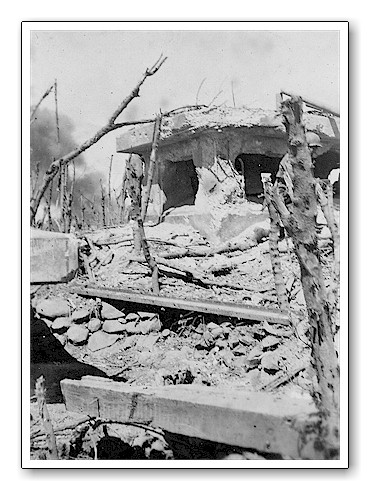
I
did not know Lee and kept him with me to put the men in defensive positions on
the east, south and west sides. A
large ventilator shaft with large openings on each side dominated the hill.
Inside the shaft, steel rungs were set in the concrete to form a ladder to the
floor of the magazine. A huge
crater was up against the east side of the shaft.
I put my headquarters here and assigned my radio operator and two runners
to guard the shaft in case Japs came up the ladder during the night.
I had an extra runner, George Mikel. Between
40 to 50 feet east of the large shaft, was a small ventilator with louvered
sides. West of the large shaft, about fifteen feet, was another small ventilator
shaft identical to the west shaft. At the southwest part of the hill was a
concrete platform about four or five feet above the ground.
Concrete steps lead up to this floor, which obviously was the floor of a
building. I know now it was the BC
Station (battery command). Underneath it was another vent shaft which I did not
notice.
John Lindgren and Don Abbott have been back to Corregidor since we were
there, once in 1987 and again in 1989. They
went over this magazine hill thoroughly, especially in 1989 when they spent a
month on the island. They found three more smaller vent shafts. I might have seen more and forgotten them, but I remember the
ones I mentioned very well, possibly because I have snap shots of the large vent
and the two smaller vents. The
hilltop was covered with wreckage - heavy timbers, corrugated steel roofing and
even at least one railroad rail. The
south side of the hill was badly scarred by one huge crater and several small
ones. This side of the hill fell
away into Cheney Ravine. The first
trees began at the concealed Belt Line Road.
I
first put one rifle squad on the west side, one on the north side, two squads on the
east, and one on the south side. This
was not right. It was too easy. The east side was the dangerous side, but with so few Japs
why worry? I asked Lee what was
wrong with this defense. He said the weak place is the east side.
That did it. Even though it was now about dark we moved S/Sgt Leroy
Jacob's 2nd squad from my platoon to
the east side and stretched Johnson's 3rd squad out to cover the west and south
sides. Now the two 2nd platoon
rifle squads and S/Sgt LeRoy Jacob's 2nd squad of my platoon were defending the
east side. This meant about
twenty-four rifleman, including three BAR's were defending about forty yards.
The odd thing here is that in the darkness, haste and confusion, the 2nd
squad lost their BAR, Richard Lampman. Somehow,
instead of Lampman, the 3rd squad's BAR, Benedict Schilli, ended up on the east
line, so there were still three BAR's there.
Later that night we were to need every man we had back there."
Richard
Lampman
"The
BAR I spent the night with was on a cement base and the gun itself had to be
elevated and rotated by hand. The
only reason I can come up with why I got left all by myself is the confusion
that went on. The only group near
me that I recall was the machine gun - they weren't exactly close either. I don't remember being fired at directly.
Now and then a shell would bounce off the old gun barrel. I always had my
BAR set on what was supposed to be "Single Fire".
As good as I was I could never get off
less than two or three rounds at a time. Maybe
the Japs thought it was a rifle. I
often wondered if anyone else that night was by themselves."
Bill
Calhoun
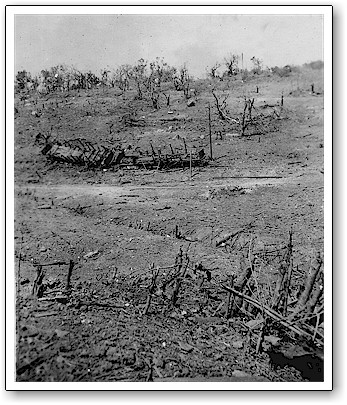 "Down
in Maggot Valley by the railroad tracks lay two wrecked trolley cars on their
sides, their floors facing us. Looking
to the northwest to Way Hill, where Bill Bailey's force was in position, all we
could see was a wooded hill which had escaped the clearing of the heavy
bombardment. We could not see them, and they could not see us. I was told that D Company was at Battery Cheney.
This battery was to our south, about 1000 yards away on the other side of
deep, heavily wooded Cheney Ravine. D
Company was strung out on a long, narrow ridge which ran from Battery Wheeler to
Battery Cheney. The battery and the ridge running back toward Battery Wheeler
could be easily seen from our hill, but the distance was too great to see the
men individually. "Down
in Maggot Valley by the railroad tracks lay two wrecked trolley cars on their
sides, their floors facing us. Looking
to the northwest to Way Hill, where Bill Bailey's force was in position, all we
could see was a wooded hill which had escaped the clearing of the heavy
bombardment. We could not see them, and they could not see us. I was told that D Company was at Battery Cheney.
This battery was to our south, about 1000 yards away on the other side of
deep, heavily wooded Cheney Ravine. D
Company was strung out on a long, narrow ridge which ran from Battery Wheeler to
Battery Cheney. The battery and the ridge running back toward Battery Wheeler
could be easily seen from our hill, but the distance was too great to see the
men individually.
They were not
incorporated into a perimeter either. Their position was a narrow finger jutting
out away from our main defenses. This
was an unsupportable salient. C Company was nearby to their east at Battery Wheeler, but being at the base of
the salient could not support D Company. Despite
being in a position where time was needed to set up a defense which covered all
routes of approach, D company were not given that time. I believe battalion gave them their
orders even later than they gave F company theirs.
It is hard
road to hoe for those of us
who were at the lower level to understand why two companies were pushed well out
from Topside into isolated positions with no provisions made far any fire
support. Moreover, there was no way to call for fire support.
At the company level our radio net was closed at dark, and our orders and
standard practice was clear, and had been so since Noemfoor - under no
circumstances were we to open a radio until dawn. No wire was strung to D or F Companies that night, either.
Every
platoon leader, and those above were given a "Special Map" of
Corregidor Island, 1:12,500 marked with pre-designated numbers and letters, (e.g.,
Battery Hearn was #19, the junction of Belt Line Road and the road in Maggot
Valley was #25, Battery Cheney was #12 and so on.) When the Japs appeared at
point #25 we should have been able to notify higher headquarters who could have
called for naval fire from the cruisers and destroyers lying off shore waiting
to give fire support, or they could have called in our 75mm howitzers, or our
81mm mortars. This was not done.
But
we were muzzled.
We
had also been lulled into over-confidence by the failure to correctly estimate
the number of Japanese troops on the island. The
prevailing thinking in our combat team when we jumped was formed from a G-2
estimate of 850 defenders. By now, at the higher levels of command, it was known
that more Japs had been counted killed than the original G-2 estimate had
pronounced upon the island. It was also known to them that our units from
Malinta Hill to western Topside were meeting heavy resistance, so a warning down
to the companies that "a heavier Jap force occupies the island than had
been originally thought" should have been
issued. Certainly the disposition of the 2nd Battalion's D and F Companies was unfortunate and should not have happened, but the confident attitude pervaded even
Topside, especially Topside, that night, which had no reserve force. The scheme of defense had
resulted in a number of strong points, and on this night, the Japanese we weren't aware of were about to test our strong points.
Just
after dark two mortar rounds struck the top of our hill, but did no damage.
Sgt. "Red Horse" Phillips and Burl Martin thought they were fired from a mortar near
Grubbs Railroad, from a position just after it turns toward Battery Grubbs and bends out of
sight. They fired five rounds into this area and we heard no more.
Lee and I were so busy placing the rifle squads into position that we
were unaware of the incoming Jap mortar rounds or of our counter-battery fire.
Perry Bandt and John Bartlett were
in the 3rd squad and on the south
side."
John
Bartlett
"I was aware of the mortars though. Bandt
and I were thinking that there was very little resistance left on the island and
we decided not to dig in for the night. About dark a mortar opened up on our
position, three or four rounds were fired.
Red Horse and I were talking about this and wondered why they quit
firing. Needless to say Bandt and I
dug in quickly."
Bill
Calhoun
"Bartlett's
statement about his and Bandt's frame of mind regarding the Jap resistance being
negligible typifies the attitude brought about by the G-2 estimate of 850 Jap
defenders.
About
2200 hours we started to hear them coming.
Along our eastern perimeter,
we could hear Japs shouting in the area, we thought, of the railroad cut. It
seemed to start with an individual shouting and the group would chant a
response. This would increase in volume until it reached a crescendo.
The all out Banzai would follow.
There is sometimes a
lot of jocularity, sing-song and camaraderie about being willing to travel to
the gates of hell with one's buddies, but truly each of us one's knew that in a
short while the gates of hell were marching up the valley towards us.
They were yelling and shouting, marching up the road along
Maggot Valley. This seemed to be the signal for a Navy star shell to explode
overhead and illuminate the area, though the Navy's
timing was simply and randomly fortuitous. The front of the Jap column could be
seen clearly near the junction of Belt Line Road and the road,#25. A
long line of a column of fours followed, proving at last
to us that the intelligence estimates were carefully crafted fantasy, rather
than military science.
It
was about 2330.
They seemed to
be trying to incite fear into us by their shouting and chanting, and were successful. Any
rifleman, put in one position and ordered to stay there, who says he didn't have
doubts as the gates of
hell came up to meet him that night wasn't there. We'd all heard and
retold the stories of Jap tactics in past battles, such as Bloody Ridge on Guadalcanal when the
Japs charged chanting "Marine you die!", "Banzai!", "Totsugeki!"
(charge), "Blood for the Emperor!" flashed again to our minds,
and we knew that shortly there would be a lot of death to be done. Arranging for
things to happen ("
Todd,
get over to Johnson and get a bandolier of ammo from everyone of his riflemen
and so many BAR clips," "Crawl up to Lee and Phillips and check
the situation," and "Send Mikal over to the north side and check
on the 1st squad and the machine guns" etc.)
kept me so
preoccupied though, that there was no time to lose concentration or presence of
mind. At the end of those thousand hours, when dawn's early light came, there
was no one among us more relieved than I.
Proving
it was not a vision, several subsequent star shells floated eerily over the
landscape. This was a battalion sized unit, 500 men or more. They were close enough for us to see that
some were sick and throwing up, yet they came.
We felt they were drunk. The booze was certainly plentiful enough.
Our
firepower was cutting swaths into their ranks, and still
they came. Groups would crumple from the explosions of our 60mm mortar
rounds scoring direct hits in the road,
and those still erect would close up ranks and keep on coming.
Soon our machine guns were also cutting swaths in their ranks.
Each
of the two mortars had 40 to 50 rounds of ammunition, but all too soon the
supply was exhausted.
Until
that hellish sight, there had been no evidence to suggest that there were so many Japanese remaining
on the entire island, yet it was no
accident that our mortar defense reserves were so robust.
We probably would not have survived with less, and if the command credit
should have gone to any single man that night, it should have gone to our
Company Commander, Bill Bailey, who was not taken off guard.
He'd planned for the worst, as a good commander should, and had laid in
to both positions a large amount of ammunition for the night.
Bill just never did toot his own horn, he was busy doing his job.
Life isn't fair, and neither is recognition in war, but he sure deserved a
Silver Star that night. He just wasn't the sort who'd see himself awarded one.
Recognition
of uncommon valor that night did come to one man, and though it interrupts the
recalling of the fight, I will tell it now because this recognition was to the most extraordinary
warrior I ever knew.
Two Congressional Medals of Honor were awarded
arising from the retaking of Corregidor, one for action on the USS Fletcher during
the pre-invasion bombardment and the other, the only land based award, was for
our first scout that evening.
Being
in the 3rd squad, Private Lloyd G. McCarter was initially on the south side of
the hill. A few of his squad were on the west side of the hill.
Red Horse was with the gun at the small east ventilator.
McCarter
had
seen some of the Japs were getting
past, and moved to the northeast corner by the 'hump' formed where the tunnel
entered the magazine."
JOHN "RED HORSE" PHILLIPS
"I
saw McCarter cross the hill from his position on the south side of the
hill and go down near the "bulge" at the northeast corner of the hill.
The "bulge" was the trolley
tunnel which ran into this corner of the hill, supplying
the magazine with heavy munitions and equipment.
McCarter,
as a 1st scout, was armed with a Thompson Sub Machine Gun. The distance from the hill to the road was too great for
effective fire for this weapon. On
his own volition, and without anyone else's knowledge, McCarter climbed his way
down the steep slope and took up a position in a shallow gulley by the side of
the road, opposite the
upturned trolley cars.
From this position he fired directly into the enemy
column. He made several trips back
to the hill that night to obtain more ammunition, changing his Thompson for a
BAR when it malfunctioned and later, when the Browning failed, to exchange it for an M-1 Garand rifle.
The BAR had become available after Schilli was wounded.
Finally even the Garand malfunctioned, its operating rod splitting!
How many rounds did he fire to cause this tough weapon to malfunction in
such a manner?
When
heavy enemy traffic going up the road had long ceased, McCarter commenced
to dueling with Japs who had taker up covered
positions around and under the trolley cars.
McCarter, short and stocky, yelled and laughed at the enemy when he was
engaged in combat, for he was one of those rare individuals which combat
transforms into a state of great exhilaration, so much so that they seem
absolutely fearless. I had seen this in him before, and
McCarter was no different that night."
BILL
CALHOUN
"The Navy flares continued to
light up the night, but in no particular pattern, they weren't constant. The
most frequent firing took place from about 2000 hours until around 0200 to 0300
hours, though. A number of Japs did get
past us, and past McCarter, evidently assembling in
the area of the rail and road junctions to our northwest toward Way Hill.
Some of them attacked Bill Bailey's force on Way Hill, and others
attacked our east perimeter. A few went on to Topside.
After
repulsing the first attack, which
came at about 2330 hours, all was
quiet for a while. After an hour or
so the chants began again and continued as before, reaching a crescendo, and
then the tide of death would flow in again.
Our confidence remained high,
though as the night drew on, there was an ever growing concern that our
ammunition might not see us through to the morning. Sometimes it would go dark maybe fifteen minutes at a stretch.
It seemed black as pitch for so long as time passed. "Where are the
flares?"
The third attack came
in the same manner as the first and second attacks, and was repulsed, but we were now
to the last of our ammunition. Johnson gathered up ammo from his 3d squad. Bayonets were fixed, and trench knives readied.
Nor did it help to have the SCR536 radio, for the net was closed.
"Where are those
flares?"
Near dawn the chants started again. The situation was critical.
Fortunately for us no attack
came. Dawn broke shortly, and the
phrase "immense relief" cannot do justice to our feelings.
Around dawn
McCarter was hit hard by a bullet in the chest,
and when it was light, he could be plainly seen in the position where he lay
down by the road. It looked to us from a ways off he was dead. Some men
went down, even though there was some fire still from a Nambu LMG, and only then was
he carried, or rather dragged,
back up the hill to its relative safety,
into a large crater near the big ventilator.
I
figured it would be mid-morning before we could get him through to Topside, and
with a bullet entry near the middle of his chest, I was worried about him going
into shock.
Our Medic, Pfc. Roy
Jensurd, had used his supply of blood plasma long before. I
went to McCarter several times to reassure him we'd get him out as soon as we could.
Each time
he told me not to worry about him, that he was doing all right. I never saw any symptoms of
shock. He was tough and complaint was not in his vocabulary."
Richard Lampman
"The next thing I can
remember was that two or three of us (I don't know who was with me) came upon a
group milling around, trying to get McCarter out of the ravine (RR track area).
The road was wider than most with steep walls on both sides. I do not
remember where it went. He was on a stretcher.
The first I knew he had been wounded.
A Jap came out of one of two large concrete double doors, open about a
foot or twenty inches behind them and threw a grenade.
It arched up and hit the steel pole that carried the electric wire and
dropped back on him. Three others and myself grabbed the stretcher and went out
of there in a hurry!! I don't know
what the rest did.
Some
of us got to look inside a day or two later. I have never seen so much black gun
powder!! It was in large bins like
we used to store oats and wheat on the farm.
We were in some other places loaded with G.P. only not so much."
BILL
CALHOUN
"At
dawn of the 19th I reported our situation to Bailey.
We were cut off to the east by the Japs in the railroad cut, and to the
north by Japs under and around the trolley
cars.
They had a Nambu LMG. Any movement
drew fire from them and the riflemen. We were out of ammunition. We had several
wounded who were in real need of medical attention. Pasquale Ruggio, of the 2nd
platoon, was hit by rifle fire from the direction of the rail-road cut and
killed. Pfc Lawrence Rainville,
mortar platoon, was wounded too. The mortar men, Sgt. Phillips, Burl Martin,
George Montoya, the young Richard "Tropical" Peterson▼, Virgil Short,
and others searched through the dozens of empty mortar shell cartons and found 5
or 6 rounds.
After
Ruggio was killed they fired these rounds at the "ditch", or railroad
cut. They thought they'd put every round in it.
Even
the .50 cal was fired towards the cut.
In
truth, there was a crater against the railroad cut which we could not see, and
there were over a dozen Japs taking very effective shelter in it. These were the
Japs who were firing at us. Those in the cut were unable to climb the high,
sheer walls to get into position to fire at us.
The
sun was up now, and the SCR 536 radio was powered up. At this point the CO of D Battery contacted me by radio.
His thin radio voice was quizzing me,
"I can see about 300 yards to
the east north-east of your position, looking straight down the cut, and see a
group of men in the cut. Are they enemy?"
"Affirmative.
They have us cut off from Topside," I responded.
"Well,
we'll soon take care of that," was his assurance.
Only
when the D Battery's 60 mm mortar battery delivered an awesome
amount of fire down the cut, where it created a carnage exploding between the
concrete walls, was the problem eliminated. Later we would find the bodies so heaped up and mutilated that
we could not get an exact body count.
We
evacuated our wounded. Pvt. Lloyd McCarter, Pfc. Benedict Schilli, Pfc. Richard Aimers, Pfc John
Albersman, Pfc. Lawrence Rainville, and one of the LMG
section men, possibly two, were wounded. All the wounded were litter cases,
which gave us some problems. S/Sgt Donald
E. White from the 2nd platoon had had moved his position on the southeast
corner forward several yards in order to better see the enemy and to control his squad. For this act of
bravery he lost his life. Pfc. Pasquale A. Ruggio, also of 2nd platoon, was
a fatality. The casualty list belied the serious situation we had been in, and
how close the Japanese had come to defeating us.
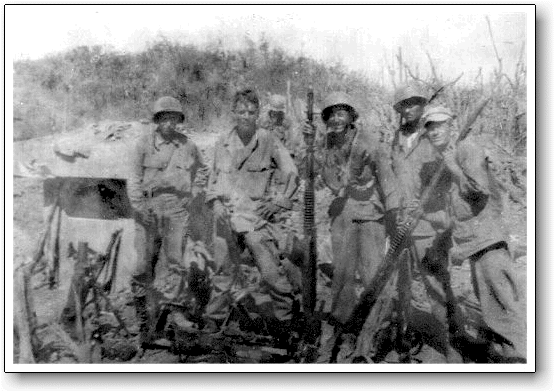
The ground is littered
with Japanese weapons and one of our conventional 60 mm mortars. We had both
of them out there. The direct fire 60 was over with Bailey's force on Way
Hill. From left to right are Richard "Tropical" Peterson (15 years old), Bill
Calhoun, George Montoya holding a Jap 50 cal. MG, Virgil Surber, and Burl
Martin holding a Jap 50 cal, MG. All the men with me are in the mortar
platoon.
The
Japanese had suffered dearly for their Bushido. The next day, the 20th, we
counted and estimated about 315 corpses, including about 200 dead along
Maggot Valley. We had to use some estimates, because the Japs had dragged many
bodies into craters, and we were not about to remove them just to count them.
There ere two very large craters on Grubbs Road which were filled to the top, as
well as several small ones. There
were 70 bodies in between our east defenses and the crater, about 30 down in the
railroad cut, and 15 in the crater adjoining the cut. Bill Bailey estimated that
his force on Way Hill had accounted for 135 more.
We destroyed or captured at least 13 machine guns.
We destroyed a HMG (Schilli's the afternoon of the 18th at the wooded
knoll, we brought six 50 cal HMG's from the valley to the top of the hill along
with five 30 cal LMG's ( three Lewis type and two Nambus) and one Nambu was
destroyed under the trolley cars. In addition there was a probable. Jack Mara tells me of a machine gun located up on Way Hill
behind the trolley cars some distance. This
gun opened up on us during the night. Qur
LMG's soon silenced this gun. We
did not get up there so we did not know if the gun was still there.
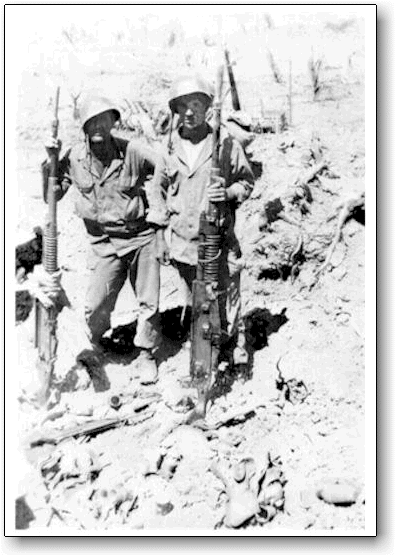
I
still have several snapshots of these guns.
In addition to John Bartlett and Perry Bandt bringing up guns, some of
the mortar platoon brought up guns. It
took two men to carry the HMG's. The
Japs tied wire or cloths around the barrel near the muzzle so the man in front
would have something to carry the gun by. I
have no memory of how we disposed of these guns.
We probably carried the LMG's with us, but I doubt if we carried the
HMG's.
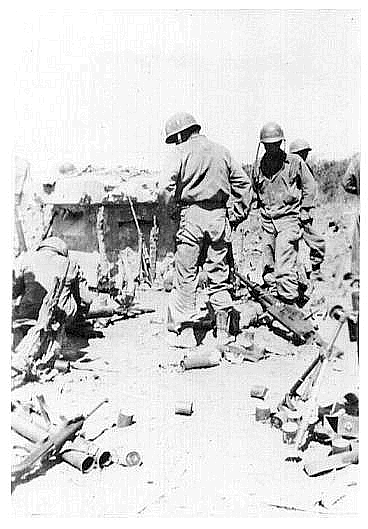
Our platoon had prevailed against a multitude of attackers in exchange
for relatively few casualties on our side. This was due to several factors.
Firstly, we held a formidable position. Secondly, our men were placed to take
the best advantage
of their position. In the face of an overall laxness, Bill Bailey had exercised great foresight in taking
precautions, seeing that both
strong points were adequately manned and supplied with extra ammunition.
Fourthly, we had to thank the
mindset of the Japanese officers, who simply failed to comprehend that the
principles of Bushido were no substitute for the principles of a good offensive
action. Their staggering incompetence to the task still stupefies me, and the
waste of the duteous servitude of their lower ranks appalls even all these years
later. Fifthly, the �lan of the U.S. paratrooper, as finely attuned
to the necessities of close combat as our years in training had been able to
make us � the best! "
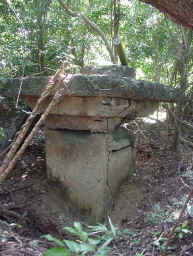
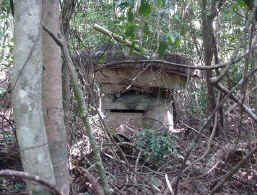
THE JUNGLE ALWAYS
WINS
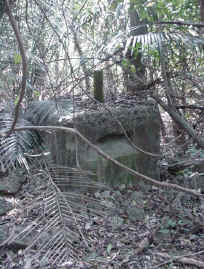
Meanwhile there had been
much action over on Bailey's
Way Hill.

►"Tropical"
jumped on Corregidor at the ripe old age of 15. He survived Corregidor
and celebrated his 16th birthday in the hills of Negros. When his age was
discovered, he was swiftly sent home.
▲
|

